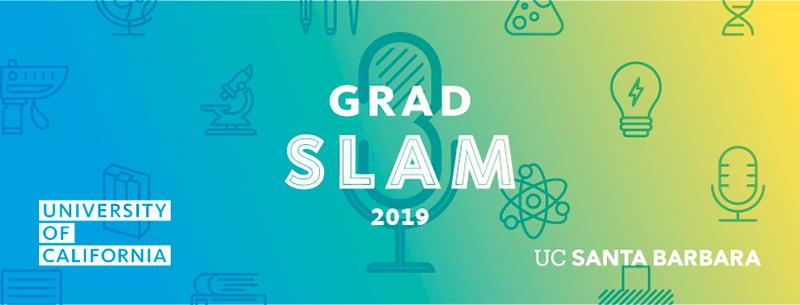Top Stories
Join us as we kick off the next stage of the 7th Annual Grad Slam with our first semifinal round! Three students from each semifinal round will advance to the final round happening later this week. Check out a preview of the presentations below and be sure to follow on Facebook for live updates on the winners of each round.

Join us as we kick off the next stage of the 7th Annual Grad Slam with our first semifinal round! âThree students from each semifinal round will advance to the final roundâ happening later this week. Check out a preview of the presentations below and be sure to follow on Facebook for live updates on the winners of each round.
SEMIFINAL ROUND 1
Mon Apr 15 | 11a-12p
SRB Multipurpose Room
Ana Sofia Guerra | âEcology, Evolution & Marine Biology
Cloudy with a Chance of Bird Poop: A Tale of Seabirds and Nutrients
Wildlife can completely transform the habitats they inhabit. Seabirds, in particular, can transform ecosystems through nutrient excretion - they continuously deposit nutrient rich feces (guano) onto terrestrial and marine environments. The Channel Islands, off the coast of Central California, support some of the largest colonies of Western Gulls, a local seabird. I am exploring the amount of guanoâ "raining" down on the islands and the impact rain of guano might have on these ecosystems.
Andrew Rowberg | Materials
Engineering High-Performance Materials for the Hydrogen Economy
Hydrogen is gaining increased visibility as a viable source of renewable energy, particularly in the transportation sector. In my research, I use computational tools to study the electronic and structural properties of high-performing, safe, solid-state hydrogen fuel cell materials at the quantum scale. Transitioning to a carbon-free society will require input from a wide range of energy sources, and I will discuss the ways in which we envision our hydrogen energy materials becoming part of that portfolio.
Avi McClelland-Cohen | âCommunication
From #MeToo to #WeToo: Constituting Movement Identity in a Digitally Networked Context
In social movement organizing, formal structures may emerge that ironically undermine a movement's ability to accomplish large-scale goals--especially so when emergent structures represent professionalized practices modeled after the business world. Trends toward professionalization of the political sector have widespread implications for whether and how movement actors achieve their goals, but the literature has not yet traced how the formalization of professional practices occurs on-the-ground in the everyday interactions of movement leaders and organizers. This project uses a contemporary case study of a large grassroots organization to examine how the communicative practices of leaders and members constitute a professional social movement organization. Findings shed light on how different approaches to power shape leaders' communicative practices, and how these practices can sometimes ironically reproduce the very structures that movement actors set out to transform.
Daniel Means | Computer Science
Detecting Disasters through Social Media
Can social media help us detect disasters to support traditional emergency alert systems? Can social media help us better understand the nature of disasters and improve our responses to them?
Fernando Temprano-Coleto | âMechanical Engineering
From Drag Reduction to Maze Solving: The Physics of Surfactants
When small amounts of surfactants are present in liquids, they can induce the so-called Marangoni effect. This can in turn trigger phenomena like the failure of drag-reducing superhydrophobic surfaces, or the visually striking maze-solving effect in open channels. My doctoral research is focused in the experimental, computational, and theoretical study of these fluid mechanics problems.
Jiajia Zheng | ââEnvironmental Science & Management
Reducing the Global Carbon Footprint of Plastics
Global life cycle GHG emissions of plastics was 1.7 Gt CO2e in 2015, which would grow to 6.5 Gt CO2e by 2050 under the current trajectory. My study demonstrates that only by using a multi-layered approach including renewable energy, recycling, bio-based plastics and slowing down our demand of plastics, can we achieve an absolute reduction.
Katelyn Zigner | Geography
Fired Up: How Advancements in Wildfire Modeling Will Help Society
Strong, downslope wind events called 'Sundowners' produce dangerous conditions for the inhabitants of coastal Santa Barbara County, CA. During these events, hot and dry air accelerates down the Santa Ynez Mountains, creating significant wildfire risks. This talk will discuss characteristics and variability of Sundowners and their impacts on wildfires.
Melissa Gordon Wolf | Education
On a Scale of One to Ten
Self-report surveys are ubiquitous in our personal lives and research, and the results can have high stakes consequences. Yet, we've all encountered moments where we've thought to ourselves: "none of these response options apply to me" or "what does this item mean?". Insofar as these moments occur, the validity of a survey's uses and interpretations is threatened. This presentation will introduce a new, evidence-based method for constructing, testing, and validating self-report survey items.
Rebecca Baker | âEnglish
Uncanny Alter(n)ity: Science Fiction and the Power of Possible Worlds
Although often denigrated as "lowbrow", science fiction--at its best--is a powerful tool for defamiliarizing, analyzing, and intervening into our complex technocultural, often dystopic realities. Sci-fi creatively reflects and reimagines how biology, technology, and culture are entangled in rich and polyvalent ways, compelling us to engage with new attention to situations and problems that are too often given up as "inevitable". This talk focuses on how sci-fi might begin to productively bridge the communication gap between the arts and sciences, opening new modes of discourse through its ever-contingent preoccupation with alienation, alterity, and the power of possible worlds.
Shashank Aswathanarayana | âââMedia Arts & Technology
I Hear Bangalore3D
I Hear Bangalore3D is an attempt to capture and render 3D recordings of various iconic locations of the city of Bangalore. First order ambisonic recordings were done and processed so that they can be played back using a speaker array configuration through real time matrixing or using headphones through binaural renderings of the recordings. This work has both aesthetic and informational use to it as it also aims at comparing the noise levels of different parts of the city at different times of the day.